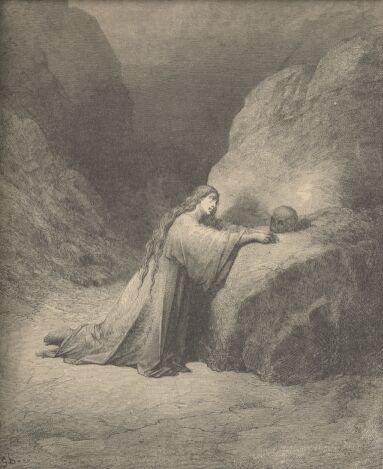MARY MAGDALENE.

|

|
Of Mary "called Magdalene" (Luke viii, 2) but few particulars are recorded in scripture. We first hear of her as having been delivered by Jesus of seven devils (Luke viii, 1-3; Mark xvi, 9). Impelled, no doubt, by gratitude for her deliverance, she becomes one of his followers, accompanying him thenceforward in all his wanderings faithfully till his death. She was the first person to whom he appeared after his resurrection (Mark xvi, 9; John xx, 1, 11-18) The common belief that she was a fallen woman is destitute of the slightest foundation. On the contrary, the references to her as being in the company of such women as Joanna, the wife of Herod's steward, Salome, the mother of James and John, and Mary, the mother of Jesus (Luke viii, 3; Mark xvi, 40; John xix, 25), strongly discountenance such a supposition. The error, which had no other source than ecclesiastical tradition, has been fostered and perpetuated by the stupid blunder of the translators of the authorized version in identifying her with the "sinner" who is described in Luke vii, 37-50 as washing the feet of Jesus with her tears (see head-note to Luke vii).
The Roman Catholic notion that this "sinner" was Mary the sister of Lazarus is almost equally groundless (see Douay Bible, head-note to Matthew xxvi, and the foot-note references to Luke vii, 37, found in most Catholic Bibles). The only reason for this identification is that the anointing by the "sinner" is described as taking place in the house of a Pharisee named Simon (Luke vii, 36, 39-40 43-44); that the anointing by the unnamed woman, as described in Matthew xxvi, 6-13 and Mark xiv, 3-9, took place in the house of one "Simon the leper," in Bethany; and that Mary, the sister of Lazarus, is described in John xi, 2, and xii, 3-8, as anointing Jesus in a house (apparently that of Lazarus himself) in Bethany, when a conversation ensues altogether different from that recorded in Luke vii, but similar to that related in Matthew xxvi, and Mark xiv, save that the objection to the anointing of Jesus is made, not by "his disciples" (Matthew xxvi, 8), not by "some that had indignation" (Mark xiv, 4), but by "one of his disciples, Judas Iscariot, Simon's son" (John xii, 4). The demeanor of Mary, the sister of Lazarus, is, however, by no means that of a fallen and sinful though penitent woman but that of a pious and good one (see Luke x, 39, 42; John xi, 28-33; xii, 3).
Dore's illustration, which portrays Mary Magdalene as a heartbroken and despairing sinner, shows that he has fallen into the common error.